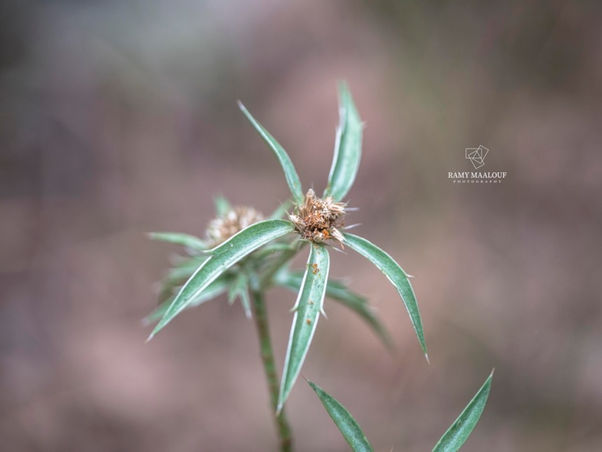Family |
Apiaceae
Eryngium falcatum
F.Delaroche
Eryngium falcatum F. Delaroche
(Nouv. Bull. Sci. Soc. Philom. Paris 1: 88; 1807 – Nouvelle Flore du Liban et de la Syrie, vol. 2, Pl. CLXXXII nº 1; 1969)
• Life-form & habit: Perennial herb with a thickened taproot and erect, branched stems 20–60 cm tall. Plant glaucous-green to bluish, rigid, often glabrous, with a characteristic metallic sheen.
• Leaves: Basal leaves long-petiolate, oblong to oblanceolate, 5–15 × 1–2 cm, margins coarsely spiny-dentate; cauline leaves sessile, amplexicaul, narrow, falcate (sickle-shaped), strongly nerved, ending in a sharp spine.
• Inflorescence & flowers: Capitula ovoid to subglobose, 1–2 cm across, surrounded by a conspicuous involucre of 5–8 long, linear-lanceolate, spiny bracts (2–4 cm). Bracts and bracteoles often bluish or violet-tinted. Flowers bisexual, densely packed, pale blue or whitish; calyx with triangular-lanceolate teeth, longer than the corolla; stamens exserted.
• Fruit: Schizocarp broadly ovoid, 2–3 mm, covered with firm scales; mericarps separating into two one-seeded parts.
• Phenology: Flowers and fruits from May to July.
• Habitat & elevation: Dry rocky slopes, calcareous pastures, and open steppe habitats, 300–1 600 m; frequent in sunny exposures, often in association with Centaurea, Echinops, and Teucrium.
• Lebanese distribution: Reported by Mouterde from Mount Lebanon and the Beqaa Valley — Dahr el-Baïdar, Zahlé, Falougha, Barouk, and Sannine slopes; also on the western Anti-Lebanon and Hermon foothills.
• Native range: East Aegean Islands, Lebanon–Syria, Palestine, Türkiye (POWO).
• ⚠️ Taxonomic note: Easily distinguished by its narrow, falcate, spiny-margined leaves and bluish bracts. Sometimes confused with Eryngium creticum Lam., but differs in its smaller heads, fewer involucral bracts, and more glaucous, bluish foliage. A characteristic thistle-like umbellifer of Levantine dry slopes.







